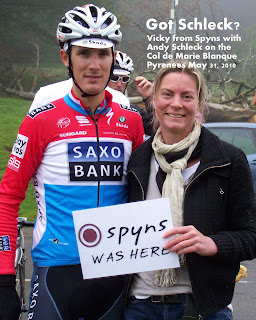www.spyns.com
 |
| Aerial View of Alpe d'Huez. |
What it lacks in elevation, mythical Alpe d’Huez more than makes up for in difficulty and notoriety. The 21 hairpin turns, 8.6 miles (13.8 km), and average 7.9% grade are unforgettable stages of any Tour de France yet Alpe d’Huez was conspicuously absent from the 2009 and 2010 Tours de France. As Le Tour celebrates is 100th anniversary in the Alps, Alpe d’Huez will again be featured as a finish for stage 19 on July 22, just 2 days before the stage 21 finish in Paris. But what exactly is Alpe d'Huez?
Alpe d’Huez is a French ski resort in the Isère department of France. Located due east of Grenoble, the mountain-top village sits 6102 ft (1860m) above sea level. Although there are higher and more technical climbs in the Alps (Tourmalet and Galibier for example) it is one of the most popular Tour de France stages and often attracts hundreds of thousands of spectators, many of whom are Dutch. Alpe d’Huez is the focus of almost rabid popularity among Dutch spectators as 8 of the first 14 stages held there were won by Dutch riders.
Lance Armstrong often destroyed his competition on Alpe d’Huez. In 2001 when he looked back at and eventually dropped an exhausted Jan Ulrich beating him to the summit by 1:59. The Tour de France 2011 makes a welcome return to Alpe d’Huez for stage 18 on July 22, 2011. What follows is an excerpt from an article written by Andrew Tilin for Slate magazine (all rights reserved):
"We reach the tiny French village of Bourg-d'Oisans, and I wave to the crowd with both hands. Then I make a big turn, the first of 21 leading to the top of the steep mountain. And I realize that I've made a terrible mistake. The race needed to end right there.
The climb up L'Alpe is so steep that Tour de France organizers don't rate its difficulty—these 10, 11, and 12 percent gradients are "beyond classification." After two turns, I'm no longer thinking about blowing kisses or drinking beers at the resort-style mountaintop village. I focus on micro-accomplishments. At first I concentrate on making it to the next switchback—it's overwhelming to think about all the climbing that's still to come. Soon, that mindset melts away in the blistering heat of the high alpine afternoon. I start concentrating on getting one more pedal stroke at a time out of my exhausted legs.
By about the fifth turn I spot Peter's [a friend and co-rider] blue, black, and silver jersey. He's standing by the side of the road. At first I'm impressed: He'd finished and come back to ride in with me! But as I inch up to him, and then past him, I realize the story is way different. "Stomach problems," he says. Peter is far from alone. There's carnage everywhere. Some riders are sitting in the melted snow runoff that comes cascading down the mountain. Others have their heads between their legs. One is puking. Another cries and gets consolation from a spectator-turned-psychotherapist. "You can still finish!" I hear her say as I creep by.
I keep going, passing riders pushing their bikes up the hill in stocking feet. A sign appears saying that I have only five kilometers to go. What seems like 30 minutes later, I see one that says, absurdly, that I'm still four kilometers away. Distance and time are now unimportant. The only thing that matters is that—even at my sluglike pace—I win the battle against gravity.
As I plod along, I notice that the wall above each switchback frames a small sign displaying the name of a pro who won on L'Alpe. Before I started this race, I wasn't sure how many cyclists took performance-enhancing drugs. Now, I'm convinced that guys like Lance Armstrong, Andy Hampsten, and Marco Pantani blazed up this thing courtesy of some godforsaken, nuclear-powered cocktail. Either that or they have extraterrestrial cardiovascular systems. Most likely, it's a combination of both.
About 90 minutes after starting the final climb, I cross the finish line. Peter finishes almost a half-hour later, but that's still a victory. More than 1,500 riders don't make it to the end. After running marathons and finishing long triathlons, I've come out the other end as a walking, talking, laughing human being. For 15 minutes I stood, with my mouth agape, waiting behind other finishers for some post-race pasta. Only when I got to the front did I realize that the line led to a parking lot. After scaling L'Alpe, I now realize that nobody knows exhaustion like a prosaic cyclist dabbling in the most hyperbolic of races."
Spyns 2011 Tour de France clients can brave Alpe d'Huez on our various cycling tours. They'll also see the stage finish there on July 22, 2011. We specialize in Tour de France packages for both riders, non-riders, and mixed tours. Spyns is an active travel company based in Whister, BC (Canada) and Beaujolais France. Spyns offers active holidays to Europe including trips to the 2011 Tour de France. For more information about Spyns 2011 Tour de France tours, please visit http://www.tdf-tours.com/ http://www.spyns.com/ or call 1.888.825.4720.




